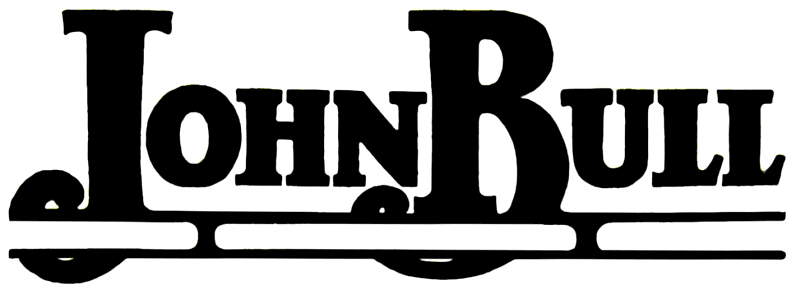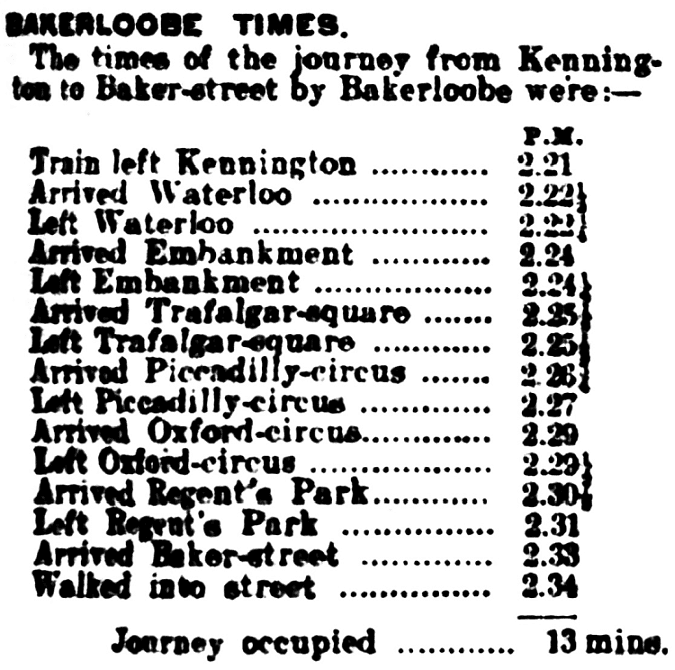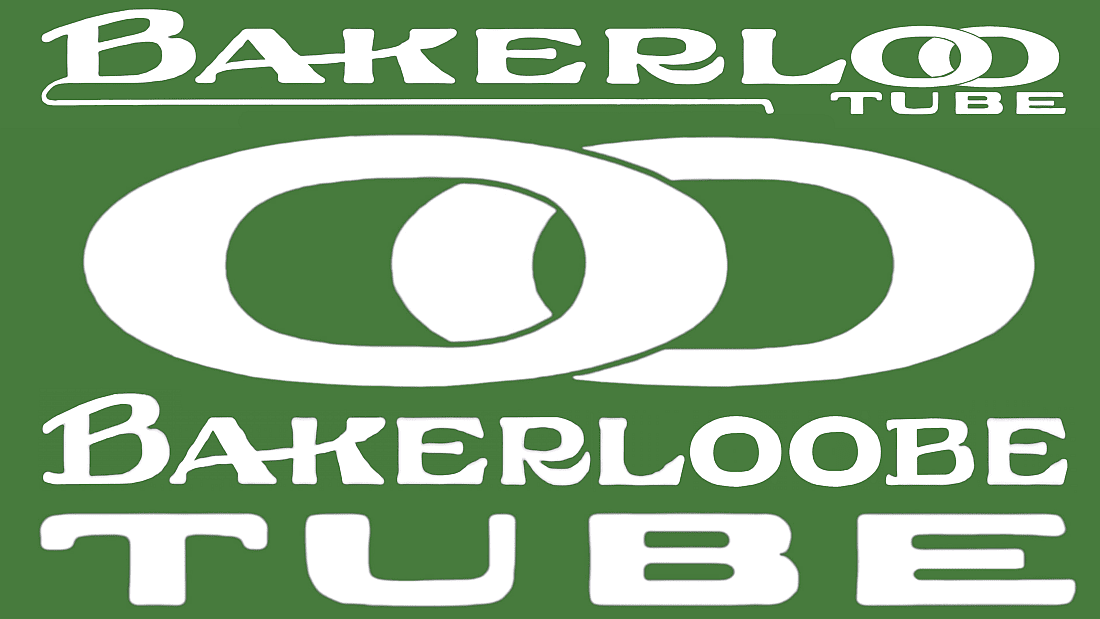This is a follow up to the early origins of the Baker Street and Waterloo Railway – including being called the Bakerloo right from the days BEFORE the line had even been opened! There was one other portmanteau name that was offered in lieu of Bakerloo – and this was the Bakerloobe. No doubt it was a clever and witty means of going that one step further than merely having ‘Bakerloo’. All the attempts to rename the new tube line in 1906 were quite numerous, but few attempts made the grade. Bakerloo was no doubt the most successful of them all – but in what was perhaps a clever sleight of hand, the Underground Electric Railway’s design department came up with a twist that clearly paid honour to this other name. That other name was ‘the Bakerloobe’. But first, some passages from the newspapers of 1906 which make reference to that name…
The Bakerloobe
The Bakerloobe, the new tube from Baker Street to Kennington, has been opened and is a great success. Thirty-seven thousand five hundred passengers were carried in the first 12 hours. (Ottawa Free Press 21st April 1906).
The directors of the Bakerloobe have resolved to increase the attraction of their train service by increasing the price of the whole journey. Already we have the Two-penny Tube, but in future the stretch of line between the Elephant and Waterloo will be known as the Threepenny Bit. (The Globe 21st June 1906).
The main driver behind ‘Bakerloobe’ was the Daily Express, and a number of other newspapers followed suit. Clearly the fact the ‘Bakerloo tube’ would possibly become the ‘Bakerloobe’ was no doubt an alternative proposition that looked quite attractive – even if only for its clever portmanteau. If anyone thought that name was never used in terms of the line’s publicity, it does seem there had been a subtle reference. As the following illustrations demonstrate, there was a sort of switcheroo to the whole thing – much like deciding whether a certain Wittgenstein drawing was a duck – or a rabbit. The sense of being able to use either modus was perhaps lost on the public and the line’s operating staff.

A demonstration of how the Bakerloo’s early signage afforded a reading of possible alternative names. Evidently the play was on ‘OO’ and ‘Tube’ (or ‘Toobe’ as it would have been pronounced), so it was up to the discerning observer whether there was also additional mechanisms at play. No doubt Bakerloo Tube was the main initiated name, but in terms of the vowel sounds, it could be switched to operate the alternative version if that was desired.
The important ‘switch’ in the above example was clearly the underlining below BAKERL…. – it seems the drop-off in this being placed directly underneath the ‘L’ was in fact an instigator that one could read the end bit as either ….Loo Tube or …Loobe.

Evidently one could if they wished, take out the ‘TU’ and read the signage as Bakerloobe. A complete one word name rather than the two words that were the generally accepted version.

There’s every certainty the UERL had never construed such a sign as ‘Bakerloobe’ – thus the above rendering is the first such example! Its an example of how things might have looked had this alternative version been adopted as the line’s official name.

Perhaps more appropriately it would look like the above rendering that’s in line with UERL’s original design. (All the above drawings were created by the author).
No matter the number of books written on London’s Underground not even the most dedicated histories of the Bakerloo line, not Charles Lee nor Clive Feather have come up with this stuff, probably because the authors wanted to keep things concise and not wander into the realms of fantasy or fatuousness. The fact (and it is a fact) is all these other names were part of an effort to deliver a jest at the line’s true business name. A serious trawl through the news archives in the first year of the Bakerloo and Water Street… damn it sorry, the Baker Street and Waterloo Railway, reveals a vast amount of historical interest that has never been discussed anywhere in the annals of London Underground history. Once again, London Rail despite all its shortcomings (and the fact its written by a disabled person which must be a considerable problem for many) has once again featured historical stuff no-one else has.
John Bull and the press versus the Bakerloobe

The main header of Bottomley’s John Bull Magazine (1906-1920). This is a generic image created by London Rail – no specific edition is alluded to.
Noted celebrities such as ‘John Bull’ were in on the act too. Bull, or rather Horatio Bottomley, MP for the Liberal Party, referenced the Bakerloobe a number of times in his John Bull magazine. The magazine is cited as an early example of Britain’s tabloid press – and it was very successful. Interestingly Bottomley details the intent of the Bakerloo line to slash its staff numbers by way of having its lift attendants double as ticket collectors too. Whether this was actually undertaken during 1906 is not known, however it was a tactic that was employed to considerable extent during the 1920s.

Horatio Bottomley on the Bakerloobe’s cost cutting tactics. John Bull 21st July 1906.
A further ditty written by Bottomley in reference to the Bakerloobe was penned on the 4th August 1906. He said:
There are to be penn’orths on the Bakerloobe. What we want now is ha’porths on the Metropolitan.
To the modern observer this must seem a strange language for it doesn’t seem to make sense. What John Bull says essentially goes like this – ‘There are to be penny tickets on the Bakerloo. What we want now is a halfpenny fare on the Metropolitan’. However the language (especially the use of ha’porths) insinuated an observed stupidity. What Bull/Bottomley suggests is the Metropolitan Railway were in a sense foolish by not adopting a reduced fare policy as that which had been undertaken by the Bakerloo when its brand new line suffered an massive drop in patronage. (This huge drop in patronage was discussed in London Rail’s earlier feature on the Bakerloo Tube).

Even the newspapers managed to come up with running times for the Bakerloobe! Daily Express 12th March 1906. The times have been reproduced below for clarity as parts of the original rendition isn’t that clear.
The times of the journey from Kennington to Baker Street by Bakerloobe were:-
Train left Kennington 2.21 pm.
Arrived Waterloo 2.22½.
Left Waterloo 2.22½.
Arrived Embankment 2.24.
Left Embankment 2.24½.
Arrived Trafalgar Square 2.25½.
Left Trafalgar Square 2.25½.
Arrived Piccadilly Circus 2.26½.
Left Piccadilly Circus 2.27.
Arrived Oxford Circus 2.29.
Left Oxford Circus 2.29½.
Arrived Regent’s Park 2.30½.
Left Regent’s Park 2.31.
Arrived Baker Street 2.33,
Walked into street 2.34 pm.
As 1906 progresses the reference to Bakerloobe very clearly dries up. It seems the point at which the media stopped using Bakerloobe was when the UERL indicated Bakerloo would be the line’s new (semi-official) name. As discussed in the previous Bakerloo article, it was pretty well accepted by May 1906 and July 1906 was when the UERL announced Bakerloo would be adopted in lieu of Baker Street and Waterloo railway. After that time the only person still using Bakerloobe was John Bull (Horatio Bottomley). Either he had no inkling of the other name being officially accepted – or he was pushing his luck and hoping the UERL would somehow have a change of heart!
One can conclude that Bakerloobe had been far better than some of the suggestions that were made. The fact it stayed the course for nearly five months no doubt shows it had the potentiality to be a serious contender. In a sense this battle of portmanteau words was thesis versus antithesis – with the ultimate synthesis being Bakerloo. There had to be two important contenders with people being able to see (or hear) which was the better choice – and in comparing Bakerloobe and Bakerloo there’s no argument the latter was the more superior choice. And that was a good thing too!
The BakerLew approaches…
In terms of the Baker Street and Waterloo railway’s name, there’s no doubt a good few jokes were raised in opposition to what was a mouthful of a title. ‘Bakerloo’ did the job well and succeeded where the grandiose title of Baker Street and Waterloo Railway had failed. In spite of that successful portmanteau the Bakerloo is still the butt of jokes even in the 21st Century – and I can think of a few convos where bizarre alternatives to the usual Bakerloo name have been conceived. As we progress through that century, possible new names continue to emerge for the Bakerloo line.
Even with the extension to Lewisham on the cards there has been every indication the next stage in the line’s evolution would be to call it the BakerLew! This very title was actually referenced to in the Mayor of London’s draft Transport Strategy 2017! BakerLew is of course seen as something of a joke as this discussion at SE23 Forum details – yet its exactly how things had stood back in 1906 too!
If the line gets as far as Hayes, some assert it would have to be known as the Bakerkent line. Its a good move however Hayes is not in Kent (and hasn’t been since 1965), thus BakerLew remains the only serious contender. The lesson that needs to be taken away from all this is its not easy to change a tube line’s name. They tried it with others especially the Victoria line – and failed. If we go back to 1906, there is every indication the original name had opened a massive can of worms. In every sense it could only be Bakerloo (with perhaps Bakerloobe in second place). Even hyphenating the name simply didn’t work.
What was important was a name everyone felt comfortable with and since the Baker Street and Waterloo Railway couldn’t be easily shortened (unlike the Great Northern Piccadilly and Brompton that gave us the Piccadilly tube and the Charing Cross Euston and Hampstead Railway for the Hampstead tube), a new name had to be found. Hence the Baker Street and Waterloo has so far been the only tube line to have this very sufferance!
Metro systems need simple, easily remembered names or alternatively line numbers or line colours. That is what has been done with the new London Overground names thus these are meant to be easy to remember. Its perhaps a little too early to conclude whether they are successful as its just a little over half a year since they were implemented. In any event its hard to make any comparisons with the Bakerloo which continues to stand out as a unique example of how a metro line name had originated.
This continues in part three with a look at the Bakerloo’s termini that weren’t.

Leave a Reply